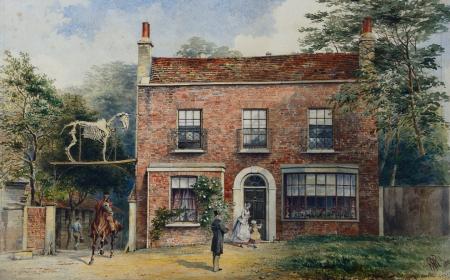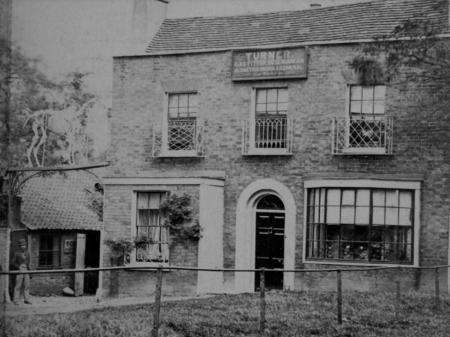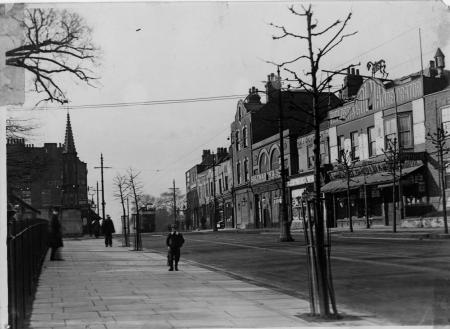
The beautifully painted watercolour (above) shows Turner’s House near the High Cross, Tottenham in 1881. The artist has paid great attention to the exquisite details of this semi-rural scene. This snapshot of everyday life (for some) in Victorian Tottenham shows an elegantly-dressed group who are either visiting the house or returning home; a horse-rider (presumably a huntsman, judging from their attire) emerges from the side entrance to the stables beyond, a stable-worker carries a bucket and a skeleton of a horse can be seen positioned high over the gateway to the stables.
A skeleton horse, that no one in this scene seems to take any notice of. Not such an everyday scene then. In fact, quite remarkable.
We learn about the story of the skeleton horse from Fred Fisk in one of the editions of his History of Tottenham (1923):
"Next to the Grammar School, standing back from the roadway with the green in front, opposite the Public Library, formerly stood a farrier or blacksmith’s shop, where the much-spoken of skeleton horse was placed over the gateway ….
At the farrier’s shop resided the family of Turner’s, one son was a farrier, another a veterinary surgeon. The statement made was that a horse belonging to a gentleman residing in Stamford Hill, which frequently passed through Tottenham, having a difficulty in dragging its load up the High Cross Hill, became a great favourite with its inhabitants.
On one occasion the horse slipped opposite the farrier’s, and in the fall broke one of its front legs. The animal was taken in hand by the veterinary Turner, and so skilfully was the broken leg set and put right, that the owner gave the horse to the vet, on condition that he did not part
with it.The horse was used for some years by the vet in pursuit of its business.
When the horse died … [he] fixed the skeleton by means of iron supports, and placed it over the farrier’s shop, where it served the purpose of an advertisement for the veterinary surgeon as well as for the farrier."
The house is described as Turner’s House at the High Cross. We know from the Census of 1871, that the head of the household at this address was Jane Turner, and she is described as a farrier. Her son William was her assistant, with another son George described as an upholsterer and her third son Thomas, a gas fitter. They also had a lodger and a general servant, Susan Nelson. There’s no mention of a veterinary surgeon, but the role of farrier at this time also included sometimes being a vet. (The Worshipful Company of Farriers consists of craft farriers, veterinary surgeons and an amalgam of persons committed to the welfare of the horse).
You can see in this photograph (below) of the house that there is a sign positioned high up in the middle of the front façade. It says ‘TURNER. GAS FITTER. BELL HANGER. & SMITH’S WORK & GENERAL. Zinc Worker etc.’. With the exception of the sign, the details in the painting and the photograph are more or less the same, including the display of flowers seen inside the house filling the whole main bay window (lower right).

The painting is dated 1881, which is a significant year for the house and the story of the skeleton horse. The scene above, photographed by Tune & Co, was likely to have been taken not long before 1881 too. That year was when Turner’s house was demolished and replaced by the striking crenellated terrace of houses of Rawlinson’s Terrace, which stand on this site today. (Rawlinson’s Terrace had been built by builder James - possibly with his son William – Stringfellow, and named after William’s wife, Emma Rawlinson).
And the skeleton horse? Well, it moved opposite to the parade of shops on Tottenham High Road and was placed on top of the ornate shop hoardings of Coleman’s the undertakers (which also advertised the family’s other trade as builders and decorators). You can spot the skeleton horse on the right of this photo from c.1905, looking north along the High Road.

Back to Fisk to finish off the story:
"When the alterations of the tram system took place, necessitating the pulling down of the old house occupied by Mr Coleman, the skeleton was taken down with the intention of replacing it on the new premises. The bones were in a wonderfully sound condition owing to many thick coatings of paint. The joints were somewhat the worse for the lengthy exposure to all weathers, but arrangements were made to have them strengthened.
After the present house was erected and the roadway widened, a note appeared in the Tottenham Herald commenting on the great improvement of the High Cross, and stating how much better the site was by the removal of the gruesome sight of a skeleton horse over an undertaker’s shop.
These remarks might have been well meant, but their effect was that Mr. Colman. Sen., became, perhaps, imbued with the same idea, and instead of having the skeleton fixed up again, had all the bones, excepting three, - cremated! One of these Mr. Colman keeps as a memento; the others were given to a Tottenham lady friend, who preserves them in her hall."
And so ends the strange tale of the skeleton horse, as told by Fisk in 1923. Who knows where those three surviving bones may be now...